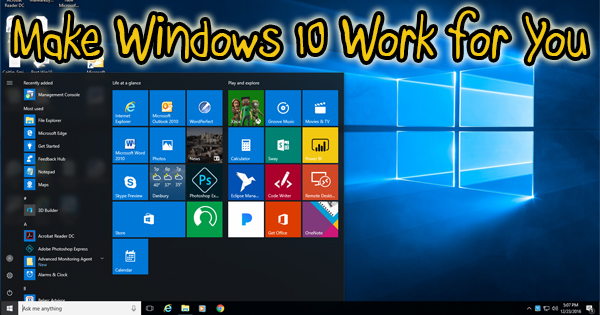
A computer is basically useless without an operating system. It can have all of the high end components and every bell and whistle you could want, but without a way for the user to input the needed information to make the machine perform as needed, you’re pretty much left with a paperweight. Back in the old days, a computer operator needed to know the ins and outs of the text line MS-DOS to make the computer function. Microsoft changed the game in 1995 with the appropriately named, Windows 95. This was the very first graphical user interface (GUI) operating system released by Microsoft. Since then, there have been many, with some loved, and others loathed. Their current version is the often maligned Windows 10. After a chilly first impression, many are now finding it to be their finest release in a number of years. One of the reasons it’s gaining traction is due to the customization that is possible, and, it’s relative ease of use. Since it’s becoming the only game in town, we thought Windows 10 deserved a look.
Personally, I hated the way Microsoft introduced Windows 10 to their customer base. For nearly a year, users were bombarded with messages touting a “free upgrade” from their previous operating system (either Windows 7 or 8), and in many cases, the optional upgrade became forced as many were shocked when their computer suddenly looked radically different the next time they came back to it. Also, I advised against doing the upgrade, because you were basically a part of a beta test for Microsoft, being their guinea pig with an unproven product. I performed around a dozen restores back to the previous operating system for clients who encountered problems. While Microsoft is continually releasing updates to Windows 10, it’s now ready for primetime. Don’t be afraid to buy a computer with Windows 10 on it, and it’s now safe to reformat a hard drive and complete a fresh installation on an existing computer.
Now that that’s settled, let’s get to the fun stuff. Windows 8 was a big disappointment for many. Since the Windows 95 days, everyone was used to having a Start button. It disappeared with Windows 8 as Microsoft went to a series of tiles (apps) instead of the familiar desktop. The Start button is back in Windows 10, and so is the desktop. I know you could get to the desktop with a Start button in Windows 8.1, but the Start button only took you back to the tiles. Windows 10 is essentially a hybrid of the popular Windows 7, and the loathed 8. If you press the Start button, you’re greeted with all of the programs (apps) that are installed on the computer on the left, and the “Windows 8-esque” tiles on the right. By default, the tiles on the left are labeled “Life at a glance”, and the tiles on the right are titled “Play and explore”. Don’t like these headlines? Change them. Click the mouse on a headline, type whatever you want it to say, and press “Enter”. Existing tiles can be removed, resized, or turned off by right-clicking on the desired title. To remove a tile, click “Unpin from Start”. What if you’d like to add tiles? Simply scroll down the list of programs on the left, find the one(s) you want, right-click and select “Pin to Start”. Add as many as you wish. Now that you have the tiles you want, how do you change the order they’re in? Click and hold the left mouse button and drag them to where you want them to go. Easy. While you were right-clicking on a program (app) in the list, you probably noticed “More” with an arrow. “Pin to Taskbar” is an option from here. If you want to add a program on the bottom of the screen (to the right of the Start button), click “Pin to Taskbar” and that program will always be visible and available on the bottom of the screen. Want to add a shortcut to the desktop? Simply left-click and drag the program to the desktop, and voila, your shortcut will be there.
The biggest challenge for me is remembering how to get everywhere I want to go on the various operating systems. I jump back and forth from Windows 7, 8, and 10 pretty regularly, but sometimes I have “one of those days”. Usually, that day is on a Monday. Anyway, Microsoft made my life easier with Windows 10. Try right-clicking on the Start button. The list that appears will make any I.T. guy’s day. Want to uninstall a program? Click “Programs and Features”. Want to change power settings? Click “Power Options”. Wondering how many megabytes of RAM your computer has? Click “System”. I won’t go through all of the options, but it’s easy to see how convenient this list can be.
Is Windows 10 perfect? Of course not. I’ll be the first to admit that my first impression was not a good one, and I really wanted to hate it. As it’s been improved with updates, and I’ve gotten to play around with it a lot more, I have to say that I’ve been converted and think that Microsoft has done a fine job. There are things that could be done better, but as far as customizing and basic ease of use go, I’m a fan.
